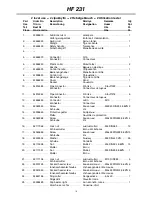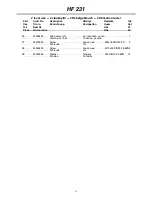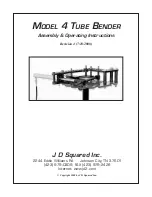
HF 231
6
1.4.OILS AND GREASES
D
Always use the oil grades recommended by the manufacturer.
D
Use the recommended oils in cold conditions.
D
Never mix different fluids or oils with each other.
D
Follow the manufacturer’s lubrication instructions.
1.5.MAINTENANCE
D
Modifications without the manufacturer’s permission are prohibited.
D
Remember that the manufacturer of the machine is not responsible for damage that is caused by:
D
modifications made without the manufacturer’s permission
D
use of non---original spare parts
D
normal wear
D
Safety devices must be re---fitted immediately after maintenance.
D
Never try to take hold of moving parts when the engine is running.
D
Ensure that the machine cannot be started during maintenance.
D
Electrical and hydraulic failures are to be repaired by authorized personnel only. The same applies to the welding of
load---bearing structures.
D
Follow the maintenance intervals listed, and perform the indicated annual safety inspections.
1.6.LIFTING
D
Lift only with the proper type of lifting device, and ensure that it has an appropriate lifting capacity.
D
Ensure that the lifting equipment is in good working condition. The lifting equipment must be inspected regularly.
D
Ensure that you know the weight of the load to be lifted and never exceed the lifting capacity stated by the manufacturer
of the lifting device.
D
Select routes for lifting that pose no danger.
2.SAFETY INSTRUCTIONS FOR HYDRAULIC SYSTEMS
1. Hydraulic systems must be serviced by qualified, experienced hydraulics mechanics only.
2. Check the machine for any leaks and repair them before using the machine.
3. Clean the area to be repaired. Do not use solvents to clean components.
4. Never repair the hydraulic system when it is pressurized.
5. Support the machine before servicing or making repairs. Do not detach the cylinders or their valves before supporting
the machine.
6. When replacing hydraulic components and hoses, use original spare parts or parts recommended by the
manufacturer. In particular, ensure that the pressure classes correspond to the operating pressure.
7. If oil gets in the eyes, rinse them thoroughly with water and consult a doctor.
8. Oil can be removed from skin by wiping and washing. Use safety equipment when handling oils and greases.
9. Prevent hydraulic oil from escaping into the environment. Waste oil must always be collected in a container to keep the
environment clean!
10.When working in ecologically sensitive areas, use bio---oils.
11.Keep oil indoors in closed, original containers. Pour the oil into the tank directly from the container.
12.All caps, funnels, screens, and filling holes must be clean.
Содержание VALBY HF 231
Страница 13: ...HF 231 13 10 HYDRAULICS CIRCUIT DIAGRAM Fig 12 43484050...
Страница 14: ...HF 231 14 HF 231...
Страница 16: ...HF 231 16 HF 231...
Страница 27: ...27...
Страница 28: ...28...
Страница 31: ......
Страница 32: ......







































